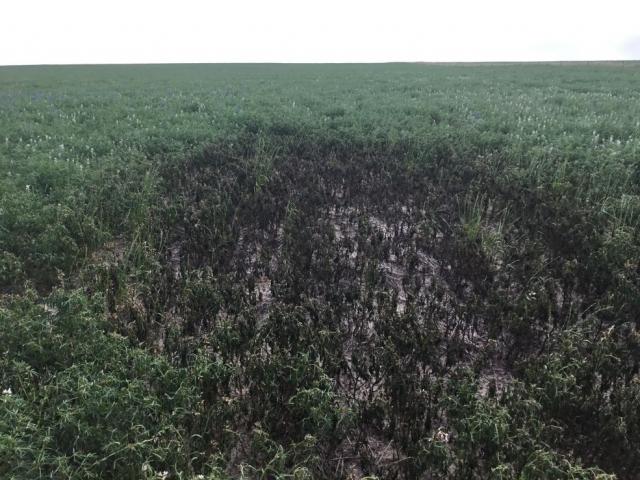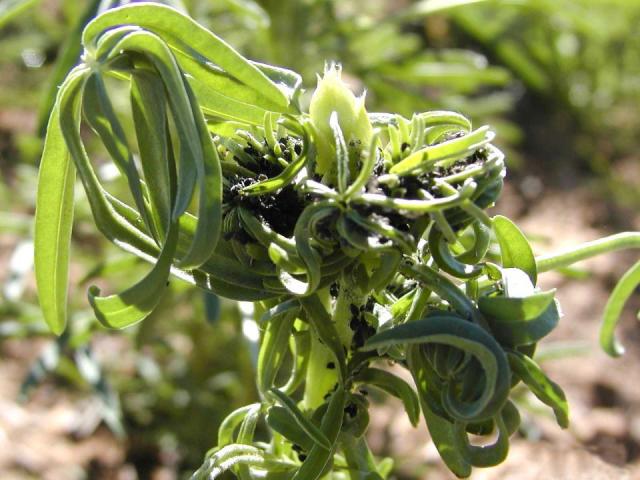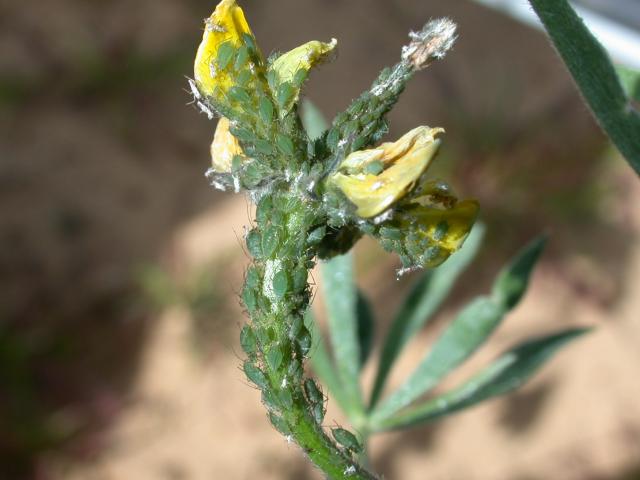Damage caused by aphids
Virus transmission
Aphids are vectors of two important lupin viruses: cucumber mosaic virus (CMV) and bean yellow mosaic virus (BYMV). Yield losses are greatest when aphids have arrived early into the crop. BYMV is not seed borne, whereas CMV can be. Lupin varieties differ in their susceptibility to viruses. See links in the 'See also' section for further information on these viruses.
Feeding damage
Lupins are most vulnerable to aphids during budding and flowering, as severe feeding damage on growing tips can cause buds to drop, flowers to abort and reduced pod set. Aphids produce a sticky substance called honeydew which coats the plant surface. Sooty mould grows on this honeydew and can further reduce plant health.
The lupin variety grown will influence the potential size of the aphid population and subsequent damage. Narrow leaf lupin varieties vary in their susceptibility to aphids. Albus lupin are considered to be resistant to aphids.
| Variety | Aphids | CMV (seed borne) | BYMV |
|---|---|---|---|
| Belara | S | MS | S |
| Coromup | R | MR | MS |
| Coyote | NA | MR | MRMS |
| Danja | MR | MR | S |
| Gungurru | MRMS | MS | S |
| Jenabillup | R | MRMS | MR |
| Jindalee | MRMS | MS | S |
| Kalya | R | MRMS | S |
| Mandelup | R | MRMS | S |
| Merrit | MRMS | MS | S |
| Myallie | MS | MRMS | MS |
| PBA Barlock | R | MR | MS |
| PBA Bateman | R | MRMS | MR |
| PBA Gunyidi | R | MRMS | MS |
| PBA Jurien | R | MRMS | MR |
| PBA Leeman | R | MS | MS |
| Quilinock | MS | MR | MR |
| Tallerack | VS | S | MS |
| Tanjil | R | R | MS |
| Wonga | R | R | MS |
| Yorrel | VS | MS | S |
 Management strategies
Management strategies
Avoiding virus transmission in crops
Cucumber mosaic virus (CMV)
CMV is spread by sowing infected seed which produces infected seedlings. Aphids pick up the virus from infected plants and spread it to nearby healthy plants. Insecticides applied to crops are ineffective at controlling CMV. Instead sow healthy seed and use cultural controls to decrease risk of aphid movement into the crop (see cultural controls on next page). For further information on CMV, refer to the Cucumber mosaic virus in narrow-leafed lupins page.
Bean yellow mosaic virus (BYMV)
BYMV is not seed-borne in lupin but is in many pasture legumes. Insecticides applied to crops are ineffective at controlling bymv. Virus sources adjacent to the crop, for example pastures or clover weeds in the crop, lead to greater BYMV spread. Managing these before seeding decreases the risk of BYMV. Also the use of cultural controls to decrease the risk of aphid movement into the crop decreases BYMV spread (see cultural controls on next page). For further information on BYMV refer to Bean yellow mosaic virus in lupins page.
Thresholds for feeding damage
Failure to control aphid feeding damage can result in yield losses (in the absence of virus infection) of up to 90% in susceptible varieties and up to 30% in varieties with intermediate resistance. Controlling aphids when they are at threshold which is 30% of flowering buds with 30 or more aphids will give a yield response.
How to monitor for aphids
After buds start to appear on the crop, check 15 plants at four different sections of the paddock. Look on the youngest inflorescences. Don't count individual aphids, instead look for clusters of aphids or symptoms of leaf curling.
Correct identification of the aphids is critical. Green peach aphids are resistant to organophosphorous, carbamate and synthetic pyrethroid insecticides, and can be difficult to control. Green peach aphids are easily identified; they tend to be found on the underside of leaves and vary in colour from bright green to pink.
Images below are (top to bottom) of cowpea aphid, blue green aphid and green peach aphid. Further information is available on the Identification of aphids in lupin crops page.
Spraying
If aphids are at threshold in the crop, the only option is to spray. Before spraying consider:
- delaying sprays if there is a cold front expected. Heavy rain combined with low temperatures (that is, less than 5°C) can severely reduce aphid numbers
- using 'soft' chemicals (such as pirimicarb) which are aphid-specific, or consider using short-term residual sprays. Aphid predators can keep low to moderate levels of aphids under control.
Perimeter spraying
In some cases the whole paddock may not need treatment, as aphid infestation often starts on the edges of a crop. If most of the infested plants are on the edge, then a perimeter spray may control most of the aphids in your paddock, saving time and money.
Cultural control strategies for aphids
High sowing rates
Use a high sowing rate of at least 80 kilograms per hectare to achieve a density of 45 plants per square metre. High plant densities form a closed crop canopy faster which is less attractive to aphids.
Stubble retention
Retained stubble help to repel aphids from landing. Stubble retention may be particularly beneficial in wide-row spaced crops, which form closed canopies later than normal-row spaced crops.
Weed control
Good weed control before and after seeding decreases the availability of alternate hosts for aphids. It also reduces the spread of viruses from weeds into the lupin crop and back again.
Encourage aphid predators and parasites
Control by predators and parasites is very reliable when low to moderate numbers of aphids are present. However, when aphids reach high levels, predators and parasites have less impact on overall numbers of aphids. Predators commonly found in lupin crops include ladybirds, lacewings and hoverflies.
Parasites include certain wasp species which are efficient at seeking out aphids. They sting the aphid and lay an egg inside. The larvae hatches and slowly consumes the aphid. This slows or stops reproduction, and eventually kills the aphid. The parasite larvae creates a 'mummy' by spinning a cocoon inside the aphid, then pupates and soon emerges as an adult. Presence of bloated aphids with a pale gold or bronze sheen indicates parasite activity in your lupin crop.



